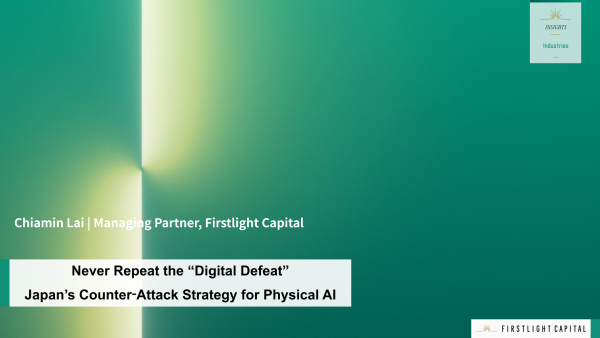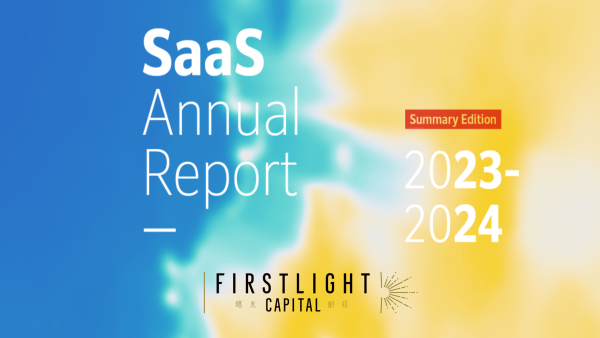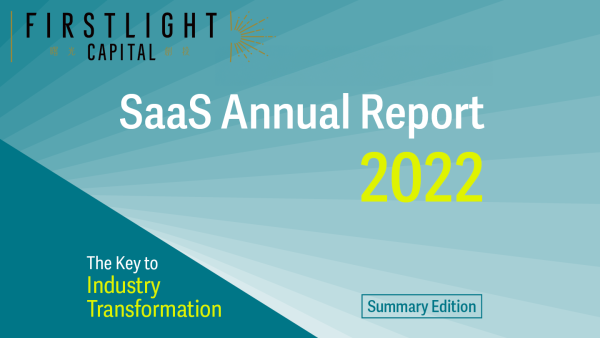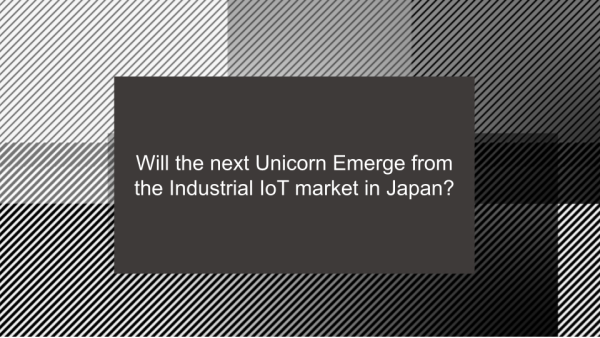The AI Agents Era: Japan’s Opportunity in the Next Industrial Revolution
2025.03.17
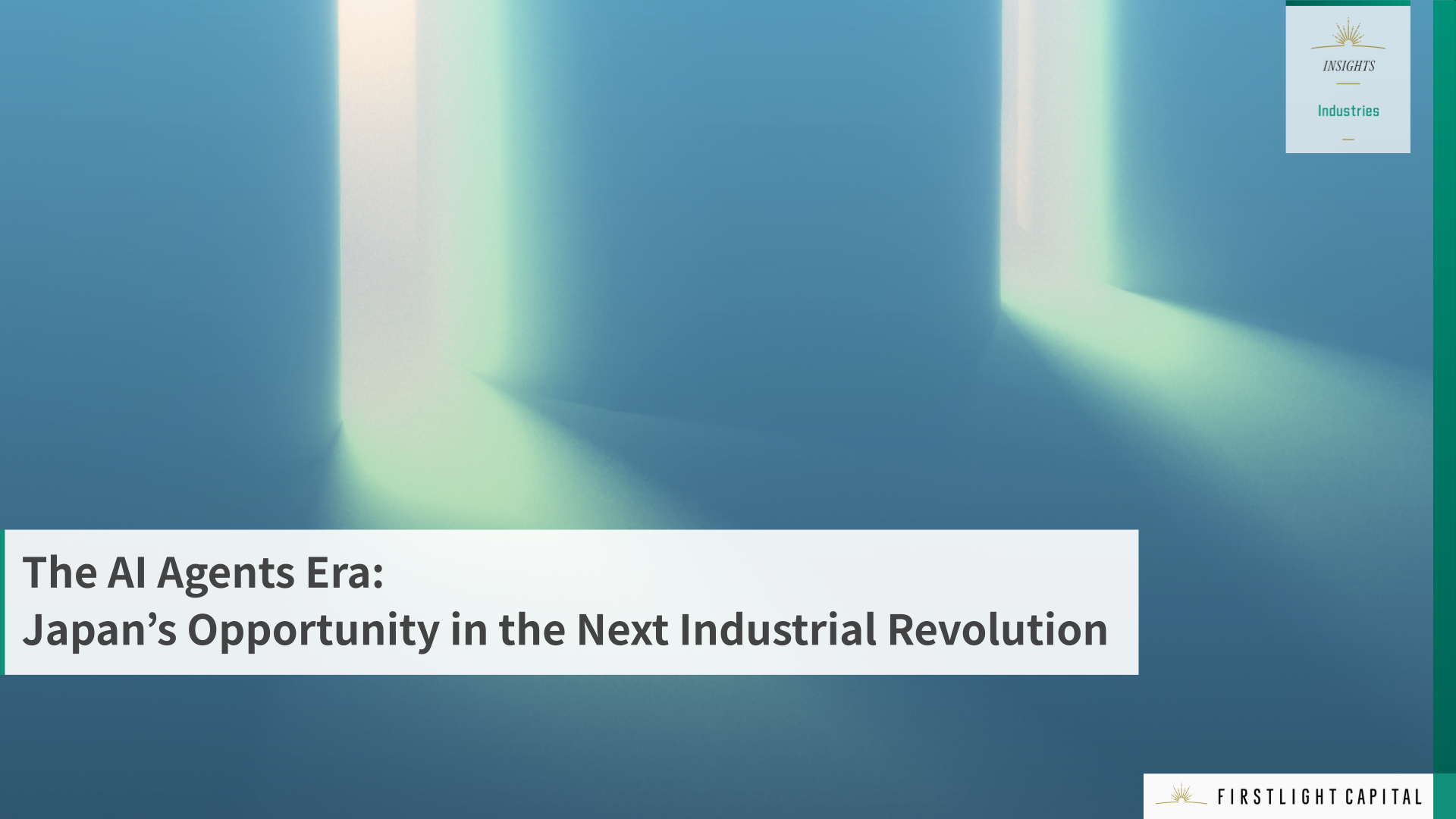
AI agents are not merely a trend but will bring about impacts comparable to an industrial revolution.
In the rapidly evolving field of AI, “AI agents” have garnered significant attention for their future potential, making them the hottest startup investment sector in the world today.
Unlike generative AI, which simply generates responses to user instructions, autonomous AI agents can integrate multiple software and services as needed to complete tasks.
Services like Decagon in the US, which learn from customer interactions and automatically handle refund processes and schedule adjustments, have already emerged. (Decagon reached a valuation of nearly $1 billion in just two years.)
Looking back through history, steam engines, electricity/internal combustion engines, and the internet have fundamentally transformed social and industrial structures.
Similarly, AI agents are likely to trigger a new transformation in the near future—”the Fourth Industrial Revolution.”
This article will explore patterns emerging from historical precedents, examine the transformative potential of AI agents, and discuss both opportunities and risks for Japanese startups.
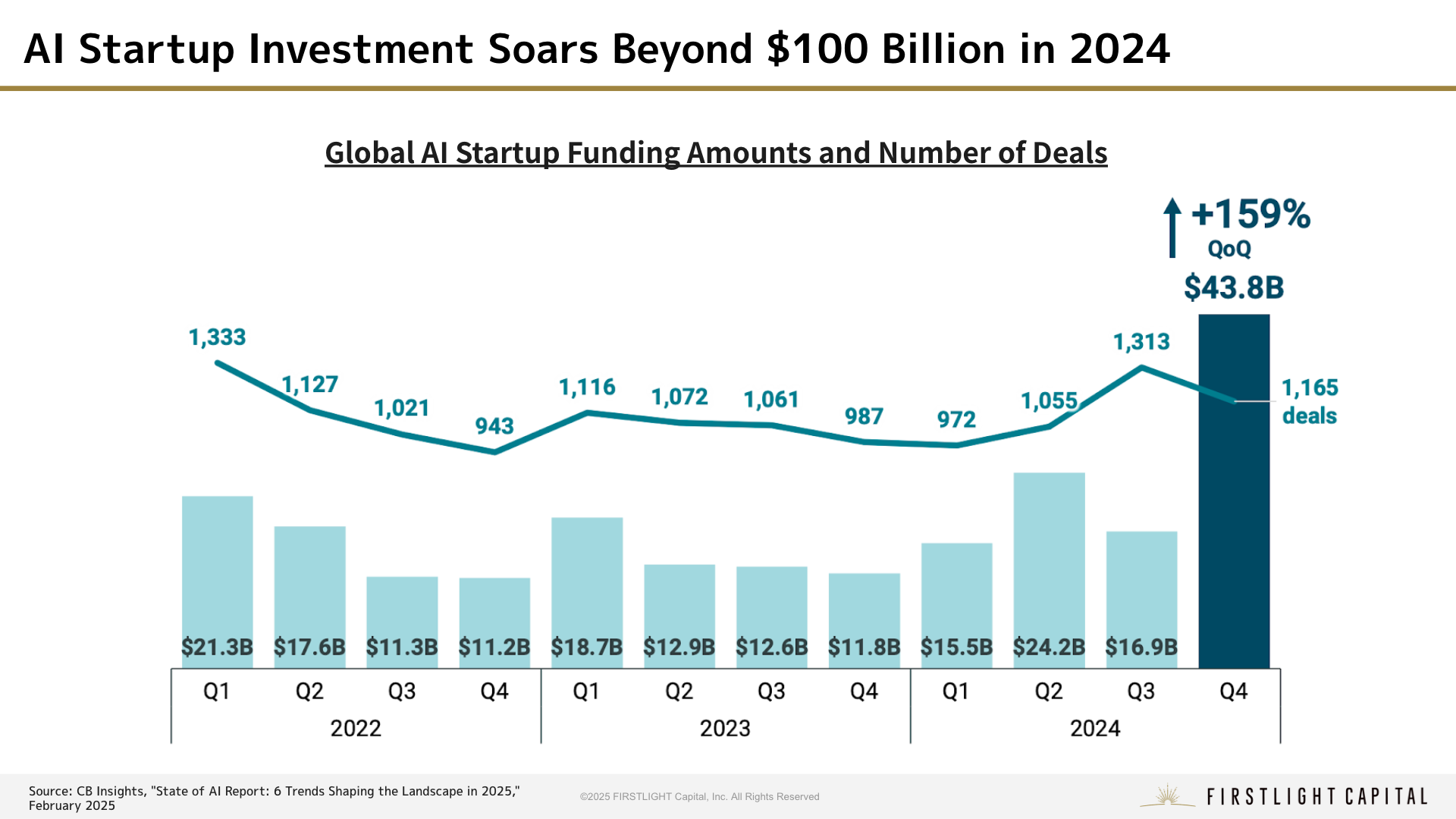
Industrial Revolutions Have Brought “Democratization”
Historically, there have been three major industrial revolutions:
1. First Industrial Revolution (Late 18th to Early 19th Century)
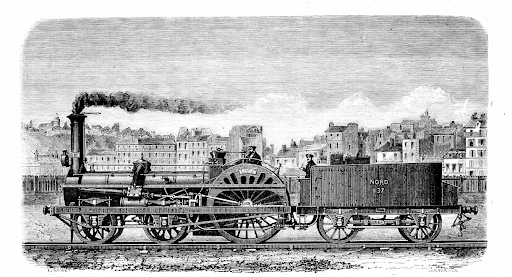
The invention of the steam engine democratized “goods” and “ideas.” Mass production made clothing and other goods available to the general public, while advances in printing technology facilitated the spread of knowledge and ideas.
- Establishment of factory production centered in Britain; development of textile and steel industries
- Increased logistics speed with the introduction of steam locomotives
- Mass production of publications through steam-powered high-speed printing presses
2. Second Industrial Revolution (Late 19th to Early 20th Century)

The practical application of electricity and internal combustion engines democratized “movement” and “labor.” Automobiles and ships made travel more accessible, while modernized heavy industry companies expanded in scale and organizational management emerged.
- Evolution of automobiles and ships through the use of internal combustion engines
- Establishment of modern management methods through corporate expansion and globalization
- Mass employment of “factory workers” through the establishment of mass production methods
3. Third Industrial Revolution (Late 20th Century Onward)

The spread of the internet democratized “information” and “entrepreneurship.” The evolution of semiconductors led to the proliferation of PCs and smartphones, enhancing mobility and labor efficiency. The emergence of the internet improved information accessibility, and the utilization of cloud services made it possible for anyone to start a business at low cost.
- PC and smartphone proliferation with mobility and efficiency gains through semiconductor evolution
- Improved information accessibility through the internet
- Lower startup costs through e-commerce, SaaS, and PaaS
Each of these revolutions involved the phenomenon of “democratization” where technological advances brought benefits to the masses.
For example, mass production through steam engines promoted the distribution of clothing and other goods, while the development of printing technology extended reading opportunities to the common people. Automobiles promoted freedom of movement, and the internet liberated information access and business activity constraints.
AI agents that symbolize the “fourth industrial revolution” are expected to democratize “knowledge” and “time.”
In addition to being able to easily acquire vast amounts of specialized knowledge in a short time by leveraging LLMs, using AI agents may dramatically expand the upper limit of tasks an individual can handle by enabling people to process multiple tasks simultaneously.
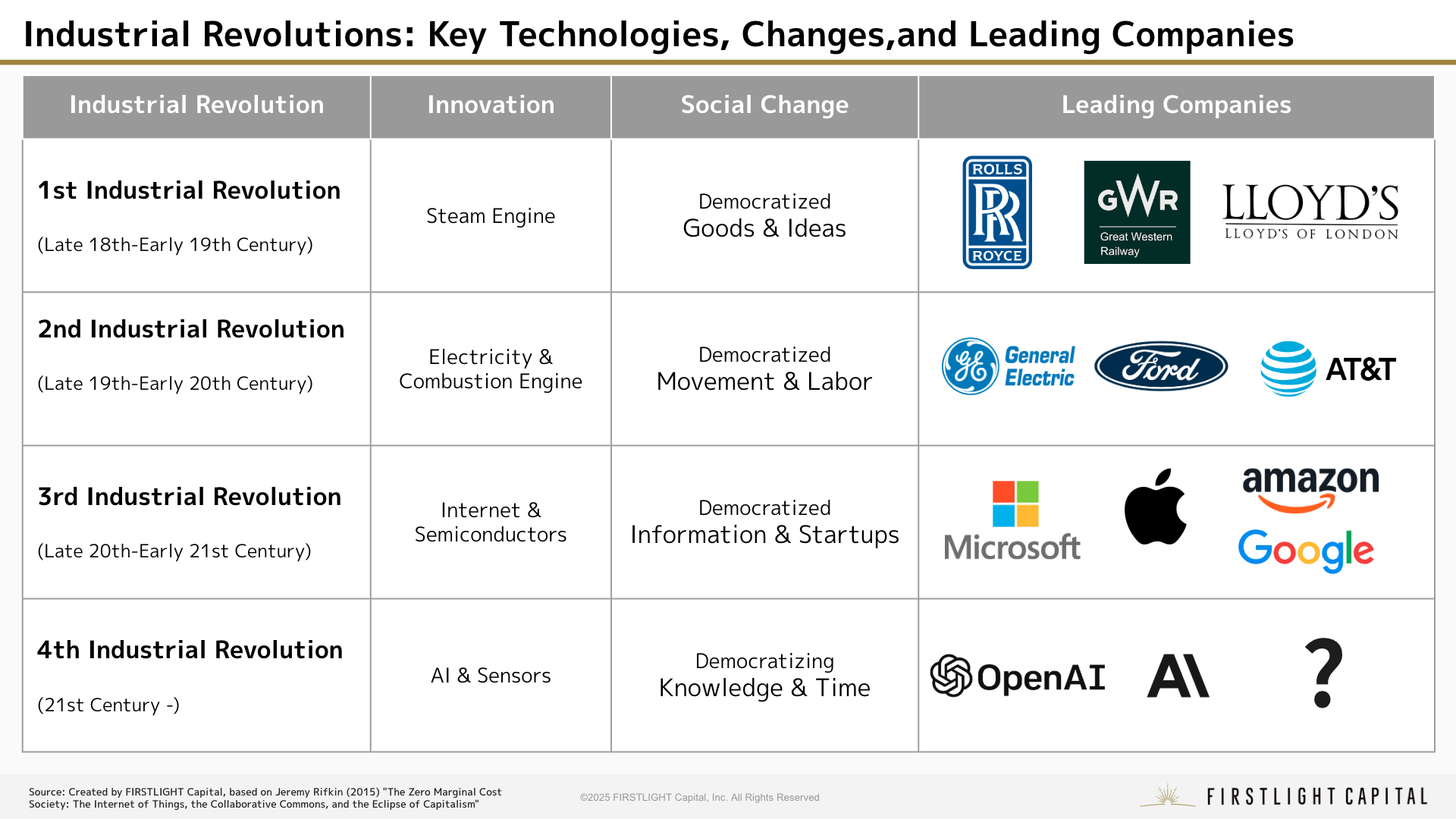
Are Bubbles and Selection Inevitable? Learning from Historical Investment Overheating
The historical pattern is clear: when new technologies emerge, investments concentrate due to growth expectations, eventually leading to oversupply and price competition, with bubble collapses triggering large-scale elimination of companies.
- First Industrial Revolution: Railway investment boom rapidly expanded, leading to the collapse of the railway bubble
- Second Industrial Revolution: Ford-style mass production system advanced, enabling mass production of various products, leading to oversupply and triggering the Great Depression (1929)
- Third Industrial Revolution: Triggered the dot-com bubble and its subsequent collapse
It’s common that as expectations for new technology rise rapidly, capital and talent quickly flow in, leading to oversupply—and when bubbles burst, the market normalizes.
Massive investments are now beginning to gather around generative AI and AI agents worldwide. This movement should not be viewed negatively; it can serve as an “accelerator” to speed up the evolution of new technologies.
However, learning from history, the flow of “overinvestment → oversupply → price competition → mass elimination” could occur, with scenarios where overheating suddenly subsides and numerous companies are eliminated.
In particular, with the efficiency improvements in software development (DevOps) utilizing AI, development costs have significantly decreased, potentially causing price disruption across the entire SaaS market.
SaaS that provides only business efficiency value is likely to become commoditized quickly. When AI agent adoption intensifies, the following industrial changes are expected to emerge:
1. Software flooding creates fierce price wars
When AI agents are utilized to mass-produce software, numerous SaaS products will flood the market, potentially leading to price competition.
2. Simple efficiency tools become obsolete
The added value of business efficiency is likely to be replaced by AI agents. SaaS that cannot find unique value through data utilization will be eliminated.
3. Startups challenge established IT vendors
Custom needs for large enterprises, long dominated by major System Integration companies, will present opportunities for startups utilizing AI agents.
4. Industry-specific data becomes the kingmaker
Proprietary data models—industry-specific data—will be recognized for their usefulness, bringing attention to vertical SaaS.
5. AI enables leaner, smaller team structures
A shift from growth linked to headcount to personnel reduction through AI utilization. The ideal organizational structure for SaaS companies will become more streamlined.
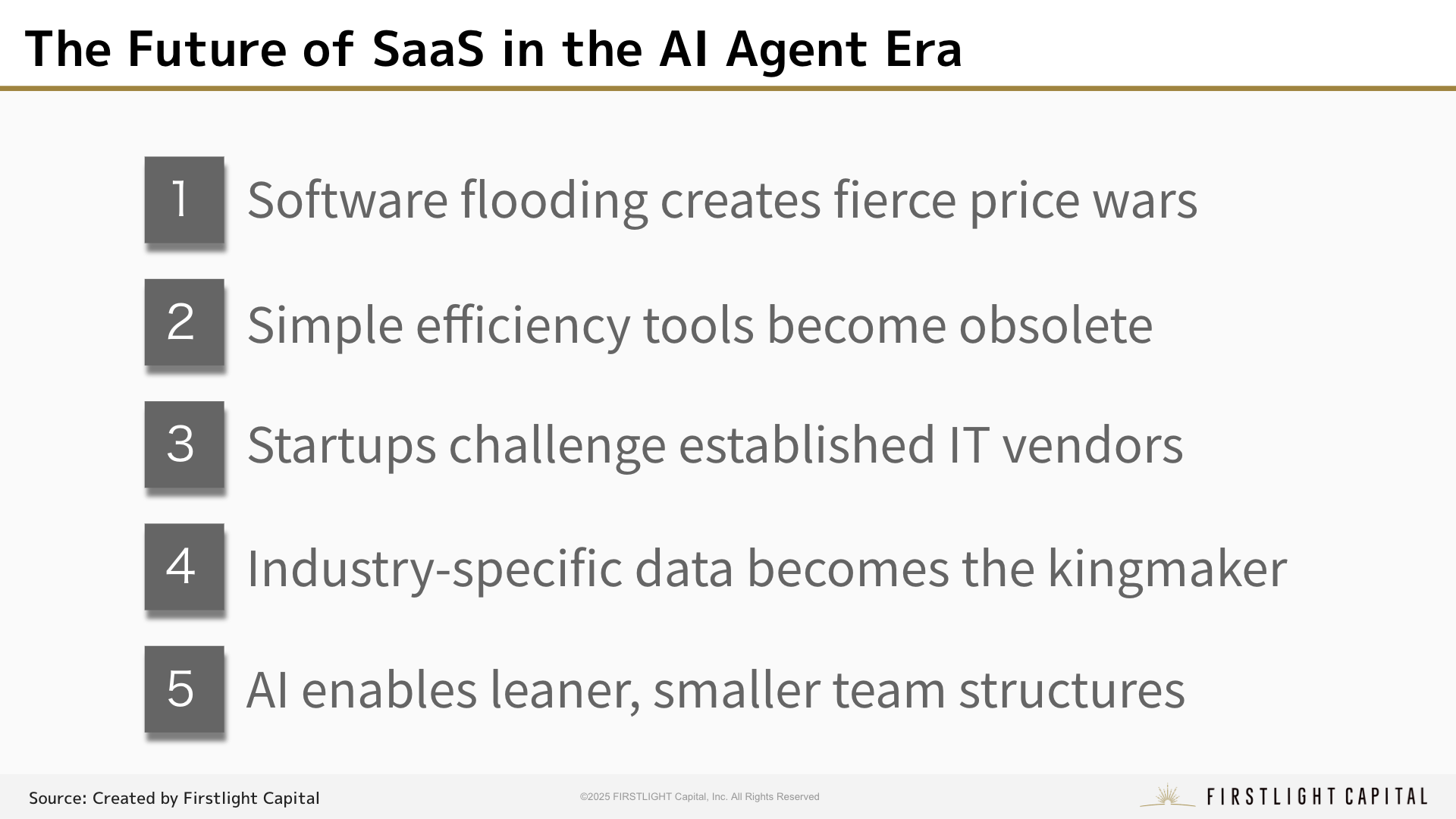
Furthermore, SaaS companies will be required to design operations centered on AI and then question their design philosophy of “Human in the Loop” (what should be left to humans?).
While a major paradigm shift is expected, just as Amazon, Google, and Salesforce survived the dot-com bubble collapse and transformed the market, the winners in this competition will likely lead the industry for the next 20 years.
The Key to AI Agent Utilization in Japan Lies in “Real Industries”
Looking at Japan, the serious social problem of labor shortages due to population decline is expected to result in the loss of about 25% of the workforce over the next 20 years. While many companies recognize the need for efficiency through Digital Transformation, implementation is delayed due to shortages of IT and DX specialists.
A survey conducted by the Organization for Small & Medium Enterprises and Regional Innovation in 2024 shows that only 18.5% of SMEs are engaged in DX, while 50.6% are considering but have not yet started implementation.
The use of AI agents is highly anticipated as a means to bridge this gap, as they allow companies without specialized IT knowledge to relatively easily implement and operate systems.
In other words, this presents an unprecedented opportunity for “domestic vertical SaaS companies” that have struggled with market development due to customer digital literacy gaps.
The real data and expertise accumulated by vertical SaaS in specific industrial areas such as construction, healthcare, and manufacturing have the potential to create exponential value when combined with AI agents.
Moreover, Japan’s market has unique business practices and regulations that present high entry barriers for foreign players. Rather, the accumulated workflows and knowledge of Japanese industry professionals have the potential to be exported overseas.
There are lessons to be learned from the Second Industrial Revolution, where Daimler, who invented the internal combustion engine, did not necessarily dominate the market; rather, Toyota and Honda grew into global manufacturers by creating vehicles that met user needs.
Large AI models (LLMs) pioneered by US companies will not necessarily monopolize everything, and Japanese startups can still find winning strategies through “narrow and deep” vertical specialization.
Which Industries Will Lead the Explosive Adoption of AI Agents?
How will the AI-driven industrial revolution progress across different sectors?
Historical patterns show that specific industries typically lead technological revolutions—textiles in the First Industrial Revolution, automobiles in the Second—with new technologies then spreading to other industries.
The AI transformation will likely begin in industries that already possess large volumes of training data through LLMs, particularly those with extensive text and voice data. Three specific areas stand out:
1. Call centers: Analysis and automation of vast customer dialogue data
2. Sales: Real-time analysis of sales conversations for optimal proposals and follow-ups
3. Legal: Labor-saving processing and analysis of text-centric documents like contracts
The next areas expected to adopt these technologies include industry-specific sectors like construction, education, and manufacturing, but their adoption will require “multimodal agents” that integrate multiple data types beyond text and voice, such as images and location information. Adoption is expected to begin with the evolution of sensing technologies in the physical world.
In the US, startups like Decagon and 11X are promoting models that almost completely delegate customer support and sales activities to AI agents. Unlike existing chatbots and RPA, they autonomously execute related tasks beyond just dialogue.
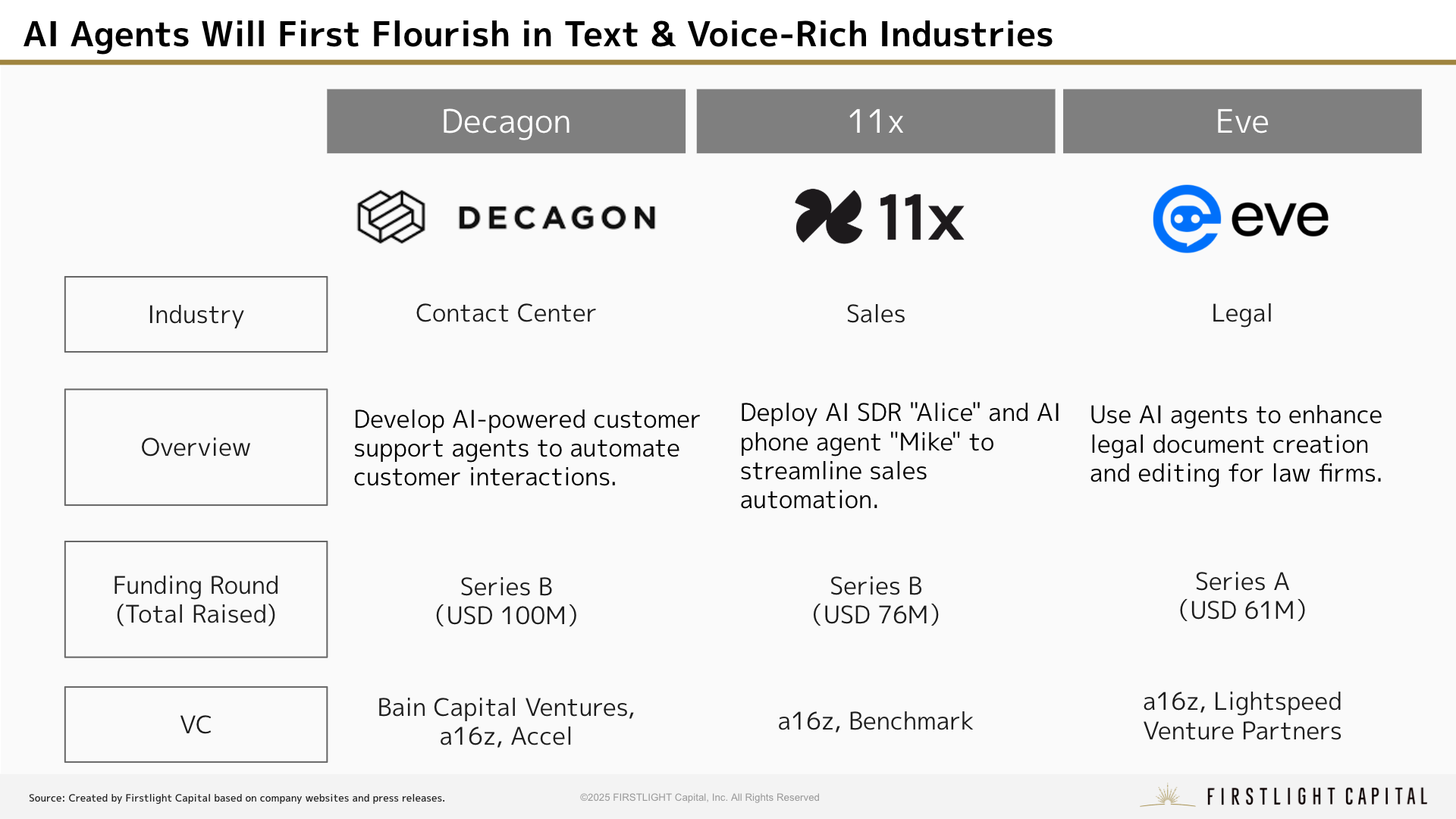
Using AI Agents to Create New Paths for Japan’s Population Decline Society
“AI agents” have the potential to become the most impactful technological innovation since the emergence of the internet in the Third Industrial Revolution.
As past industrial revolutions have shown, investment bubbles are inevitably followed by oversupply and elimination phases, but great opportunities await companies that weather these storms.
Japan, facing population decline ahead of other nations, has the opportunity to use AI agents to cover labor shortages and further increase productivity.
Japan faces structural issues including labor shortages and lack of DX talent as the first country to confront population decline on a global scale. However, these constraints may actually enhance the effectiveness of AI agents.
If industry-specific data and business know-how cultivated in vertical SaaS sectors are utilized, there is significant potential to build new SaaS × AI models ahead of the world.
Now is the time to harness this wave of industrial transformation for Japan’s future.
Written by: Osamu Iwasawa | FIRSTLIGHT Capital General Partner
Edited by: Akio Hayafune | FIRSTLIGHT Capital Chief Analyst
Here at FIRSTLIGHT Capital, we regularly deliver useful content on both Japanese and global startup trends, as well as hands-on experience from our very own venture capitalists and specialists. Please feel free to contact us via the CONTACT page if you would like to be in touch. Click here to follow FIRSTLIGHT Capital’s SNS account!

